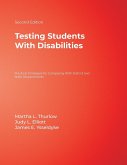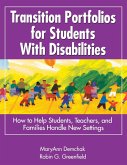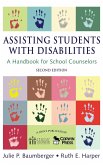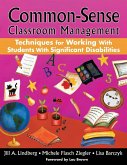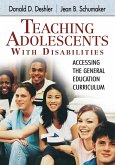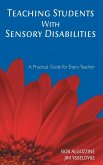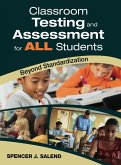Martha L. Thurlow, Judy L. Elliott, James E. Ysseldyke
Testing Students With Disabilities
Practical Strategies for Complying With District and State Requirements
Martha L. Thurlow, Judy L. Elliott, James E. Ysseldyke
Testing Students With Disabilities
Practical Strategies for Complying With District and State Requirements
- Gebundenes Buch
- Merkliste
- Auf die Merkliste
- Bewerten Bewerten
- Teilen
- Produkt teilen
- Produkterinnerung
- Produkterinnerung
The timely revision of this best-selling guide offers specific tactics to effectively and meaningfully include students with disabilities in assessment systems.
Andere Kunden interessierten sich auch für
![Testing Students With Disabilities Testing Students With Disabilities]() Martha L. ThurlowTesting Students With Disabilities52,99 €
Martha L. ThurlowTesting Students With Disabilities52,99 €![Transition Portfolios for Students With Disabilities Transition Portfolios for Students With Disabilities]() Mary Ann DemchakTransition Portfolios for Students With Disabilities41,99 €
Mary Ann DemchakTransition Portfolios for Students With Disabilities41,99 €![Assisting Students With Disabilities Assisting Students With Disabilities]() Julie P. BaumbergerAssisting Students With Disabilities75,99 €
Julie P. BaumbergerAssisting Students With Disabilities75,99 €![Common-Sense Classroom Management Techniques for Working With Students With Significant Disabilities Common-Sense Classroom Management Techniques for Working With Students With Significant Disabilities]() Jill A. LindbergCommon-Sense Classroom Management Techniques for Working With Students With Significant Disabilities41,99 €
Jill A. LindbergCommon-Sense Classroom Management Techniques for Working With Students With Significant Disabilities41,99 €![Teaching Adolescents With Disabilities Teaching Adolescents With Disabilities]() Donald D. DeshlerTeaching Adolescents With Disabilities47,99 €
Donald D. DeshlerTeaching Adolescents With Disabilities47,99 €![Teaching Students With Sensory Disabilities Teaching Students With Sensory Disabilities]() Bob AlgozzineTeaching Students With Sensory Disabilities64,99 €
Bob AlgozzineTeaching Students With Sensory Disabilities64,99 €![Classroom Testing and Assessment for ALL Students Classroom Testing and Assessment for ALL Students]() Spencer J. SalendClassroom Testing and Assessment for ALL Students87,99 €
Spencer J. SalendClassroom Testing and Assessment for ALL Students87,99 €-
-
-
The timely revision of this best-selling guide offers specific tactics to effectively and meaningfully include students with disabilities in assessment systems.
Hinweis: Dieser Artikel kann nur an eine deutsche Lieferadresse ausgeliefert werden.
Hinweis: Dieser Artikel kann nur an eine deutsche Lieferadresse ausgeliefert werden.
Produktdetails
- Produktdetails
- Verlag: Corwin
- 2. Auflage
- Seitenzahl: 344
- Erscheinungstermin: 6. Dezember 2002
- Englisch
- Abmessung: 286mm x 221mm x 23mm
- Gewicht: 1126g
- ISBN-13: 9780761938088
- ISBN-10: 0761938087
- Artikelnr.: 21417819
- Herstellerkennzeichnung
- Libri GmbH
- Europaallee 1
- 36244 Bad Hersfeld
- gpsr@libri.de
- Verlag: Corwin
- 2. Auflage
- Seitenzahl: 344
- Erscheinungstermin: 6. Dezember 2002
- Englisch
- Abmessung: 286mm x 221mm x 23mm
- Gewicht: 1126g
- ISBN-13: 9780761938088
- ISBN-10: 0761938087
- Artikelnr.: 21417819
- Herstellerkennzeichnung
- Libri GmbH
- Europaallee 1
- 36244 Bad Hersfeld
- gpsr@libri.de
Martha L. Thurlow, Ph.D., is Director of the National Center on Educational Outcomes in the Institute on Community Integration (University Center for Excellence in Developmental Disabilities) at the University of Minnesota. In this position, she addresses the implications of contemporary U.S. policy and practice for students with disabilities and English Language Learners, including national and statewide assessment policies and practices, standards-setting efforts, and graduation requirements. Dr. Thurlow has conducted research for the past 35 years in a variety of areas, including assessment and decision making, learning disabilities, early childhood education, dropout prevention, effective classroom instruction, and integration of students with disabilities in general education settings. She has published extensively on all of these topics, and also recently completed serving as co-Editor with Bob Algozzine of Exceptional Children, the research journal of the Council for Exceptional Children. Dr. Thurlow is a co-author of several books, including Testing Students with Disabilities, Improving Test Performance of Students with Disabilities, Alternate Assessments for Students with Disabilities, and Critical Issues in Special Education. Dr. Thurlow was one of the original developers of the dropout prevention program Check and Connect, which was empirically tested, and replicated in several settings. She is the author of numerous reports, journal articles and chapters on the topic of dropouts and dropout prevention, and also addresses the dropout problem within the current context of federal legislation, high stakes testing, and standards-based education.
Preface
About the Authors
1. Why Students With Disabilities Should Be in District and Statewide
Accountability Systems
2. Deciding How Students Participate in District and State Tests
3. Assessment Accommodations: Who Is Eligible? For What?
4. Accommodations to Consider
5. Alternate Assessments
6. Including English Language Learners With Disabilities in District and
State Assessments
7. Using Assessment Results
8. An Important Tool: The IEP
9. Collaboration for Success in Testing Students With Disabilities
10. Gaining Support From Above: What Needs to Happen
11. Involving Parents in Testing Decisions
12. Implementation: The Good, The Bad, and The Ugly
Resources: Reproducible Forms
Resources: Staff Development
Resources: Technical Assistance and Dissemination Networks
Index
About the Authors
1. Why Students With Disabilities Should Be in District and Statewide
Accountability Systems
2. Deciding How Students Participate in District and State Tests
3. Assessment Accommodations: Who Is Eligible? For What?
4. Accommodations to Consider
5. Alternate Assessments
6. Including English Language Learners With Disabilities in District and
State Assessments
7. Using Assessment Results
8. An Important Tool: The IEP
9. Collaboration for Success in Testing Students With Disabilities
10. Gaining Support From Above: What Needs to Happen
11. Involving Parents in Testing Decisions
12. Implementation: The Good, The Bad, and The Ugly
Resources: Reproducible Forms
Resources: Staff Development
Resources: Technical Assistance and Dissemination Networks
Index
Preface
About the Authors
1. Why Students With Disabilities Should Be in District and Statewide
Accountability Systems
2. Deciding How Students Participate in District and State Tests
3. Assessment Accommodations: Who Is Eligible? For What?
4. Accommodations to Consider
5. Alternate Assessments
6. Including English Language Learners With Disabilities in District and
State Assessments
7. Using Assessment Results
8. An Important Tool: The IEP
9. Collaboration for Success in Testing Students With Disabilities
10. Gaining Support From Above: What Needs to Happen
11. Involving Parents in Testing Decisions
12. Implementation: The Good, The Bad, and The Ugly
Resources: Reproducible Forms
Resources: Staff Development
Resources: Technical Assistance and Dissemination Networks
Index
About the Authors
1. Why Students With Disabilities Should Be in District and Statewide
Accountability Systems
2. Deciding How Students Participate in District and State Tests
3. Assessment Accommodations: Who Is Eligible? For What?
4. Accommodations to Consider
5. Alternate Assessments
6. Including English Language Learners With Disabilities in District and
State Assessments
7. Using Assessment Results
8. An Important Tool: The IEP
9. Collaboration for Success in Testing Students With Disabilities
10. Gaining Support From Above: What Needs to Happen
11. Involving Parents in Testing Decisions
12. Implementation: The Good, The Bad, and The Ugly
Resources: Reproducible Forms
Resources: Staff Development
Resources: Technical Assistance and Dissemination Networks
Index


